Abstract
1. The effect of thyrotropin releasing hormone (TRH) administration upon acetylcholine (ACh) release in freely moving rats was investigated by means of transversal microdialysis coupled to h.p.l.c. TRH administered either s.c. or via local perfusion increased the ACh release from cortex and hippocampus but not from the striatum. The increase in ACh release was maintained after 7 days of s.c. administration of TRH. 2. After s.c. injection of the neuropeptide, the increase in ACh release was dose-dependent and reached a maximum at 40 min after administration. The maximal percentage increases were 18, 52, 66 and 89% at doses of 1, 2.5, 5 and 10 mg kg-1 and 35, 48 and 54% at doses of 2.5, 5 and 10 mg kg-1 in the cortex and hippocampus, respectively. The effect of TRH was dependent on neuronal activity since it was completely inhibited by perfusion with tetrodotoxin (TTX), 5 X 10(-7) M. 3. Perfusion with TRH, 2.5 micrograms microliters-1, caused 198% and 150% increase in ACh release 60 and 80 min after the beginning of the perfusion in the cortex and hippocampus, respectively. After this initial peak, a 100% increase in ACh release persisted throughout the perfusion. 4. Systemic TRH administration was followed by marked hyperactivity and stereotyped behaviour that showed a time course shorter than that of the increase in ACh release. 5. These findings demonstrate that TRH exerts a strong stimulant action on cortical and hippocampal cholinergic pathways.
Full text
PDF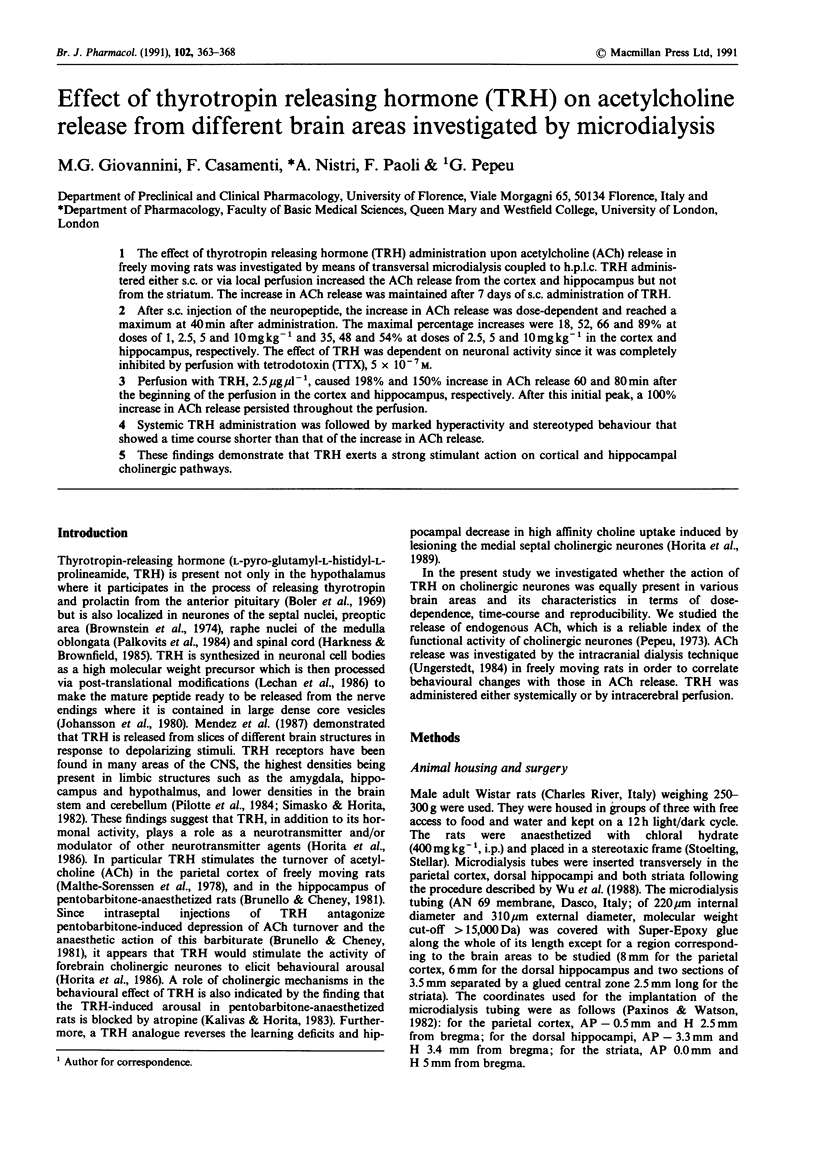
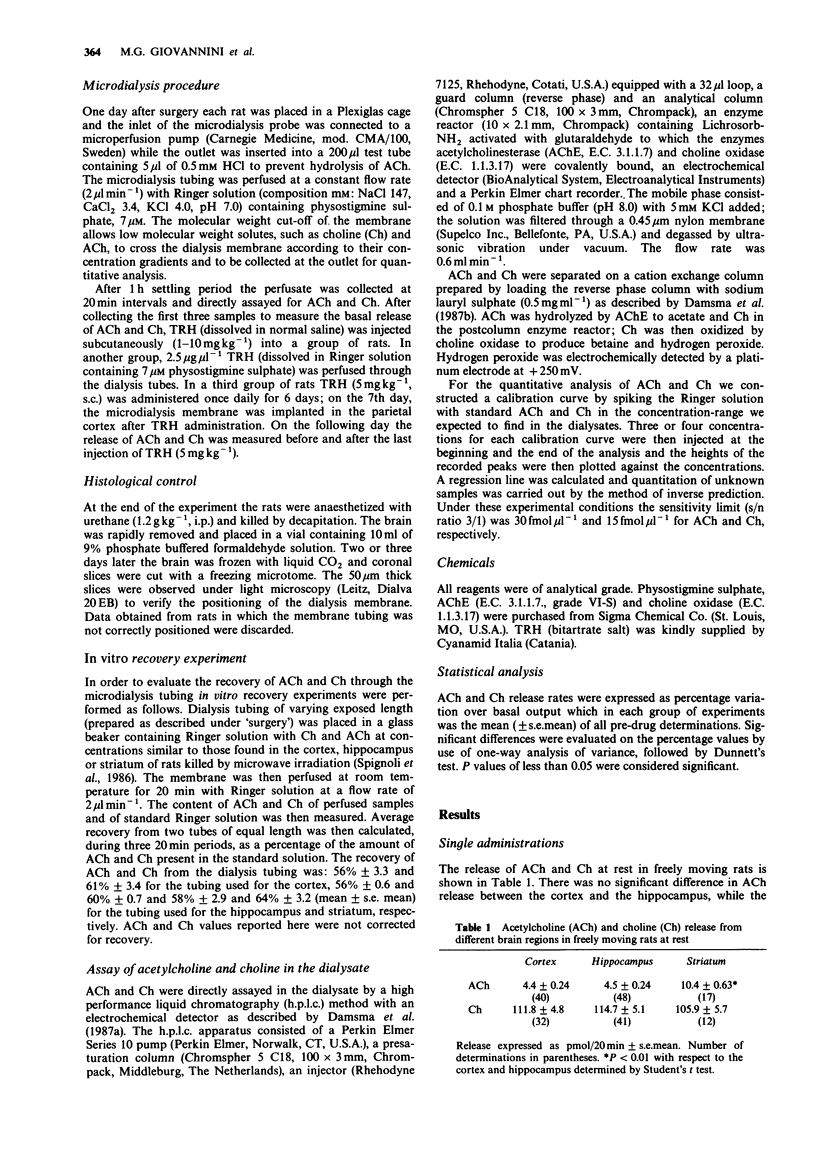
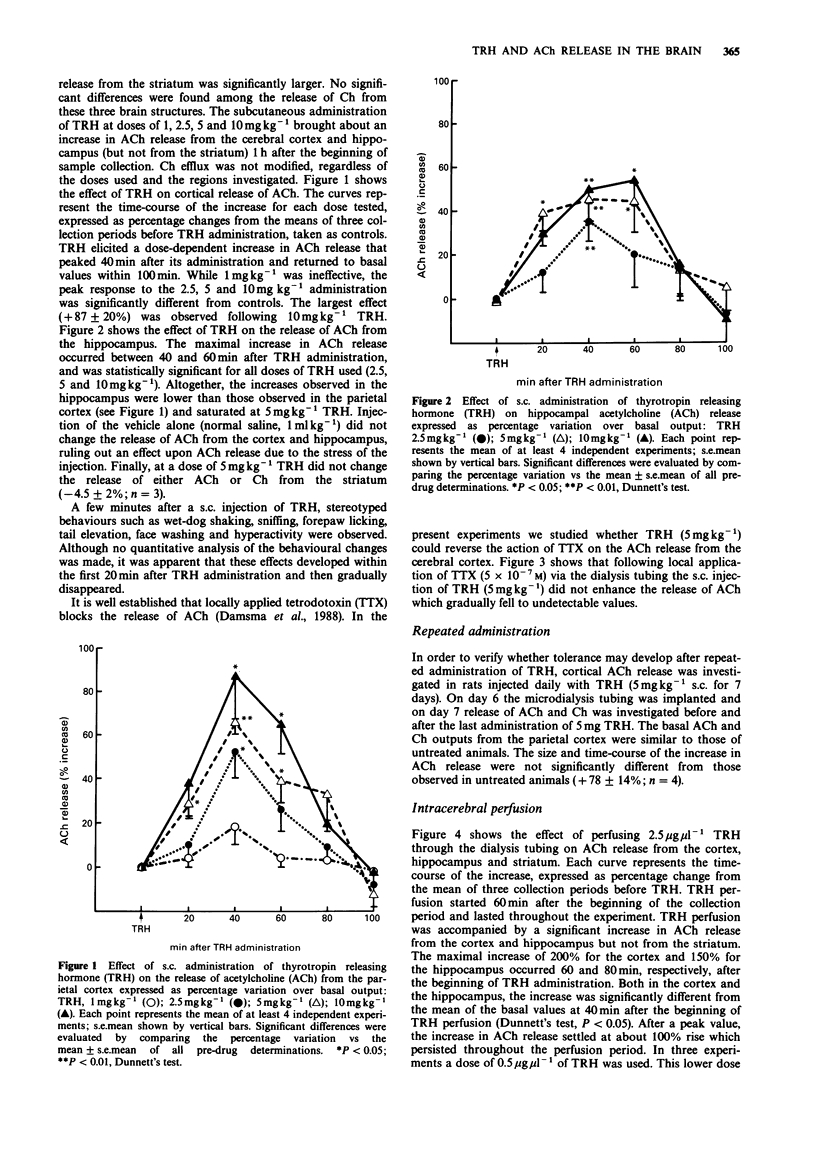
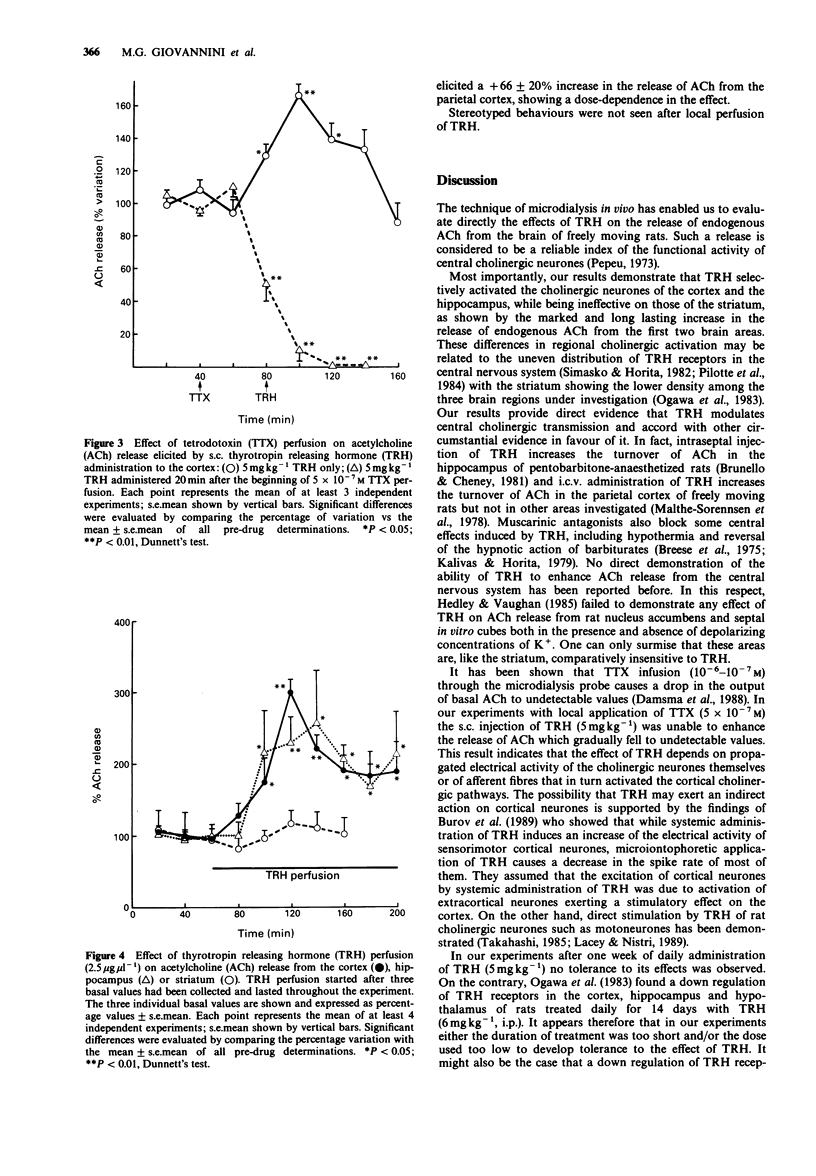
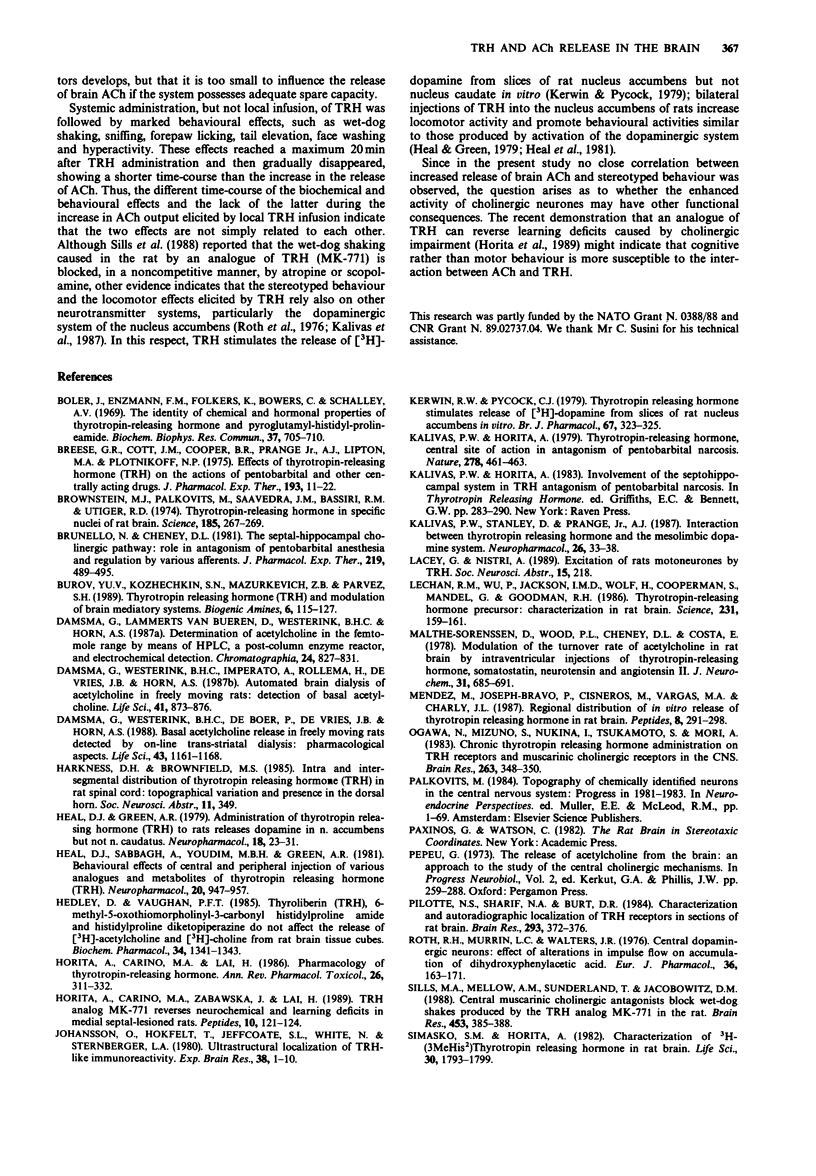

Selected References
These references are in PubMed. This may not be the complete list of references from this article.
- Boler J., Enzmann F., Folkers K., Bowers C. Y., Schally A. V. The identity of chemical and hormonal properties of the thyrotropin releasing hormone and pyroglutamyl-histidyl-proline amide. Biochem Biophys Res Commun. 1969 Nov 6;37(4):705–710. doi: 10.1016/0006-291x(69)90868-7. [DOI] [PubMed] [Google Scholar]
- Breese G. R., Cott J. M., Cooper B. R., Prange A. J., Jr, Lipton M. A., Plotnikoff N. P. Effects of thyrotropin-releasing hormone (TRH) on the actions of pentobarbital and other centrally acting drugs. J Pharmacol Exp Ther. 1975 Apr;193(1):11–22. [PMC free article] [PubMed] [Google Scholar]
- Brownstein M. J., Palkovits M., Saavedra J. M., Bassiri R. M., Utiger R. D. Thyrotropin-releasing hormone in specific nuclei of rat brain. Science. 1974 Jul 19;185(4147):267–269. doi: 10.1126/science.185.4147.267. [DOI] [PubMed] [Google Scholar]
- Brunello N., Cheney D. L. The septal-hippocampal cholinergic pathway: role in antagonism of pentobarbital anesthesia and regulation by various afferents. J Pharmacol Exp Ther. 1981 Nov;219(2):489–495. [PubMed] [Google Scholar]
- Damsma G., Westerink B. H., Imperato A., Rollema H., de Vries J. B., Horn A. S. Automated brain dialysis of acetylcholine in freely moving rats: detection of basal acetylcholine. Life Sci. 1987 Aug 17;41(7):873–876. doi: 10.1016/0024-3205(87)90184-6. [DOI] [PubMed] [Google Scholar]
- Damsma G., Westerink B. H., de Boer P., de Vries J. B., Horn A. S. Basal acetylcholine release in freely moving rats detected by on-line trans-striatal dialysis: pharmacological aspects. Life Sci. 1988;43(14):1161–1168. doi: 10.1016/0024-3205(88)90475-4. [DOI] [PubMed] [Google Scholar]
- Heal D. J., Green A. R. Administration of thyrotropin releasing hormone (TRH) to rats releases dopamine in n. accumbens but not n. caudatus. Neuropharmacology. 1979 Jan;18(1):23–31. doi: 10.1016/0028-3908(79)90005-4. [DOI] [PubMed] [Google Scholar]
- Heal D. J., Sabbagh A., Youdim M. B., Green A. R. Behavioural effects of central and peripheral injection of various analogues and metabolites of thyrotropin releasing hormone (TRH). Neuropharmacology. 1981 Oct;20(10):947–957. doi: 10.1016/0028-3908(81)90025-3. [DOI] [PubMed] [Google Scholar]
- Hedley D., Vaughan P. F. Thyroliberin (TRH), 6-methyl-5-oxothiomorpholinyl-3-carbonyl histidylproline amide and histidylproline diketopiperazine do not affect the release of [3H]-acetyl choline and [3H]-choline from rat brain tissue cubes. Biochem Pharmacol. 1985 Apr 15;34(8):1341–1343. doi: 10.1016/0006-2952(85)90517-9. [DOI] [PubMed] [Google Scholar]
- Horita A., Carino M. A., Lai H. Pharmacology of thyrotropin-releasing hormone. Annu Rev Pharmacol Toxicol. 1986;26:311–332. doi: 10.1146/annurev.pa.26.040186.001523. [DOI] [PubMed] [Google Scholar]
- Horita A., Carino M. A., Zabawska J., Lai H. TRH analog MK-771 reverses neurochemical and learning deficits in medial septal-lesioned rats. Peptides. 1989 Jan-Feb;10(1):121–124. doi: 10.1016/0196-9781(89)90087-9. [DOI] [PubMed] [Google Scholar]
- Johansson O., Hökfelt T., Jeffcoate S. L., White N., Sternberger L. A. Ultrastructural localization of TRH-like immunoreactivity. Exp Brain Res. 1980;38(1):1–10. doi: 10.1007/BF00237924. [DOI] [PubMed] [Google Scholar]
- Kalivas P. W., Horita A. Thyrotropin-releasing hormone: central site of action in antagonism of pentobarbital narcosis. Nature. 1979 Mar 29;278(5703):461–463. doi: 10.1038/278461a0. [DOI] [PubMed] [Google Scholar]
- Kalivas P. W., Stanley D., Prange A. J., Jr Interaction between thyrotropin-releasing hormone and the mesolimbic dopamine system. Neuropharmacology. 1987 Jan;26(1):33–38. doi: 10.1016/0028-3908(87)90041-4. [DOI] [PubMed] [Google Scholar]
- Kerwin R. W., Pycock C. J. Thyrotrophin releasing hormone stimulates release of [3H]-dopamine from slices of rat nucleus accumbens in vitro. Br J Pharmacol. 1979 Nov;67(3):323–325. doi: 10.1111/j.1476-5381.1979.tb08682.x. [DOI] [PMC free article] [PubMed] [Google Scholar]
- Lechan R. M., Wu P., Jackson I. M., Wolf H., Cooperman S., Mandel G., Goodman R. H. Thyrotropin-releasing hormone precursor: characterization in rat brain. Science. 1986 Jan 10;231(4734):159–161. doi: 10.1126/science.3079917. [DOI] [PubMed] [Google Scholar]
- Malthe-Sorenssen D., Wood P. L., Cheney D. L., Costa E. Modulation of the turnover rate of acetylcholine in rat brain by intraventricular injections of thyrotropin-releasing hormone, somatostatin, neurotensin and angiotensin II. J Neurochem. 1978 Sep;31(3):685–691. doi: 10.1111/j.1471-4159.1978.tb07841.x. [DOI] [PubMed] [Google Scholar]
- Mendez M., Joseph-Bravo P., Cisneros M., Vargas M. A., Charli J. L. Regional distribution of in vitro release of thyrotropin releasing hormone in rat brain. Peptides. 1987 Mar-Apr;8(2):291–298. doi: 10.1016/0196-9781(87)90104-5. [DOI] [PubMed] [Google Scholar]
- Ogawa N., Mizuno S., Nukina I., Tsukamoto S., Mori A. Chronic thyrotropin releasing hormone (TRH) administration on TRH receptors and muscarinic cholinergic receptors in CNS. Brain Res. 1983 Mar 21;263(2):348–350. doi: 10.1016/0006-8993(83)90328-1. [DOI] [PubMed] [Google Scholar]
- Pepeu G. The release of acetylcholine from the brain: an approach to the study of the central cholinergic mechanisms. Prog Neurobiol. 1973;2(3):259–288. doi: 10.1016/0301-0082(73)90009-9. [DOI] [PubMed] [Google Scholar]
- Pilotte N. S., Sharif N. A., Burt D. R. Characterization and autoradiographic localization of TRH receptors in sections of rat brain. Brain Res. 1984 Feb 20;293(2):372–376. doi: 10.1016/0006-8993(84)91246-0. [DOI] [PubMed] [Google Scholar]
- Roth R. H., Murrin L. C., Walters J. R. Central dopaminergic neurons: effects of alterations in impulse flow on the accumulation of dihydroxyphenylacetic acid. Eur J Pharmacol. 1976 Mar;36(1):163–171. doi: 10.1016/0014-2999(76)90268-5. [DOI] [PubMed] [Google Scholar]
- Sills M. A., Mellow A. M., Sunderland T., Jacobowitz D. M. Central muscarinic cholinergic antagonists block wet-dog shakes produced by the TRH analog MK-771 in the rat. Brain Res. 1988 Jun 21;453(1-2):385–388. doi: 10.1016/0006-8993(88)90184-9. [DOI] [PubMed] [Google Scholar]
- Simasko S. M., Horita A. Characterization and distribution of 3H-(3MeHis2)thyrotropin releasing hormone receptors in rat brain. Life Sci. 1982 May 24;30(21):1793–1799. doi: 10.1016/0024-3205(82)90315-0. [DOI] [PubMed] [Google Scholar]
- Spignoli G., Pedata F., Giovannelli L., Banfi S., Moroni F., Pepeu G. Effect of oxiracetam and piracetam on central cholinergic mechanisms and active-avoidance acquisition. Clin Neuropharmacol. 1986;9 (Suppl 3):S39–S47. [PubMed] [Google Scholar]
- Takahashi T. Thyrotropin-releasing hormone mimics descending slow synaptic potentials in rat spinal motoneurons. Proc R Soc Lond B Biol Sci. 1985 Sep 23;225(1240):391–398. doi: 10.1098/rspb.1985.0068. [DOI] [PubMed] [Google Scholar]
- Wu C. F., Bertorelli R., Sacconi M., Pepeu G., Consolo S. Decrease of brain acetylcholine release in aging freely-moving rats detected by microdialysis. Neurobiol Aging. 1988 Jul-Aug;9(4):357–361. doi: 10.1016/s0197-4580(88)80081-2. [DOI] [PubMed] [Google Scholar]


